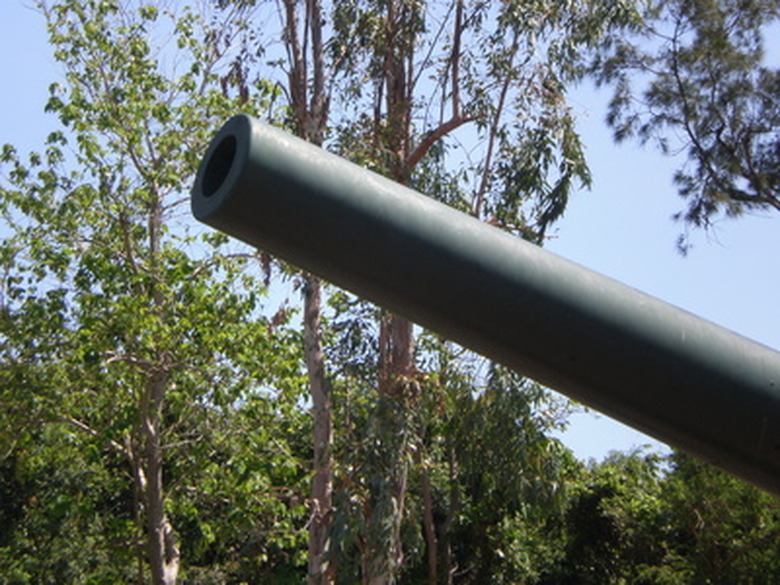How To Calculate Vertical Speed
When projectiles move in the world as we know it, they move through three-dimensional space, between spots that can be described in terms of coordinates in an (x, y, z) system. When people study these moving projectiles, be they objects in a sports contest such as baseballs or multi-billion-dollar military aircraft, they want to know how certain isolated details about that object's path through space, not the whole story from every literal angle at once.
Physicists study the positions of particles, the change of those positions over time (i.e., velocity) and how that change in position itself changes over time (i.e., acceleration). Sometimes, the vertical velocity is the item of special interest.
Basics of Projectile Motion
Basics of Projectile Motion
Most problems in introductory physics are treated as having horizontal and vertical components, represented by x and y respectively. The third dimension of "depth" is reserved for advanced courses.
With that in mind, the motion of any projectile can be described in terms of its position (x, y or both), velocity (v), and acceleration (a or g, the acceleration due to gravity), all with respect to time (t), indicated by subscripts. For example, vy(4) represents the vertical velocity (i.e. in the y-direction) at time t = 4 seconds after the particle starts moving. Likewise, a subscript of 0 means t = 0 and tells you the initial position or velocity of the projectile.
Ordinarily, you need only refer to the correct or equation or equation from among Newton's classic equations of projectile motion:
\(v_{0x}= v_x \
x = x_0+ v_xt\)
(The above two expressions are for horizontal motion only).
\(y = y_0 + \frac{1}{2}(v_{0y}+ v_y)t\)
\(v_y= v_{0y} − gt\)
\(y = y_0+ v_{0y}t − \frac{1}{2}gt\)
\(v_y^2 = v_{0y}^2 + 2g(y − y_0)\)
- **Speed vs. Velocity:** Note that speed is simply a number that does not account for a particle's direction, whereas velocity is more specific and includes x and y information.
Vertical Velocity Equation: Projectile Motion
Vertical Velocity Equation: Projectile Motion
Which vertical velocity formula to select from the above list when trying to determine vertical velocity (represented by vy0, which is velocity at time t = 0, or vy, the vertical velocity at unspecified time t) will depend on the kind of information you are given at the start of the problem.
For example, if you are given y0 and y (the total change in vertical position between t = 0 and the time of interest), you can use the fourth equation in the above list to find v0y, the initial vertical velocity. If you are instead given elapsed time for an object in free fall, you can calculate both how far it has fallen and its vertical velocity at that time using other equations.
- Note that in all of these problems, the real-world effects of air resistance are ignored.
- Objects in free fall have a negative value for v, since "downward" is in the negative y-direction.
Motion in a Vertical Circle
Motion in a Vertical Circle
Picture yourself swinging a yo-yo or other small object on a string in a circle in front of you, with the circle traced out by the object exactly perpendicular to the floor. You notice the object slowing down as it reached the very top of the swing, but you keep the speed of the object just high enough to maintain tension in the string.
As you may have guessed, there is a physics equation describing this sort of vertical circular motion. In this kind of centripetal (circular) motion, the acceleration needed to keep the string taut is v2/ r, where v is the centripetal velocity and r is the length of the string between your hand in the object.
Solving for the minimum vertical velocity at the top of the string (where a must be equal to or greater than g) gives vy = (gr)1/2, meaning that the speed doesn't depend on the mass of the object at all and only on the length of the string
Vertical Velocity Calculator
Vertical Velocity Calculator
You can avail yourself of a variety of online calculators to help you solve physics problems that deal in some way with a vertical component of displacement, and therefore have a projectile with vertical velocity that you might want to find at a given time t. An example of such a website is provided in the Resources.
Cite This Article
MLA
Beck, Kevin. "How To Calculate Vertical Speed" sciencing.com, https://www.sciencing.com/calculate-vertical-speed-7492314/. 21 December 2020.
APA
Beck, Kevin. (2020, December 21). How To Calculate Vertical Speed. sciencing.com. Retrieved from https://www.sciencing.com/calculate-vertical-speed-7492314/
Chicago
Beck, Kevin. How To Calculate Vertical Speed last modified August 30, 2022. https://www.sciencing.com/calculate-vertical-speed-7492314/
